BSBWHS4010 Assessment: Implementing and Monitoring WHS Procedures
VerifiedAdded on 2023/01/19
|41
|8471
|65
Homework Assignment
AI Summary
This document serves as a comprehensive assessment guide for the BSBWHS4010 unit, focusing on the implementation and monitoring of Workplace Health and Safety (WHS) policies, procedures, and programs to meet legislative requirements. It outlines the elements of competency, performance and knowledge evidence, and foundation skills necessary for successful completion. The guide details assessment criteria, including providing information to the work team, implementing participation arrangements, managing WHS training, identifying hazards, controlling risks, and maintaining WHS performance. It includes assessment tools such as learner workbooks, observation checklists, major and skills & knowledge activities, case studies, and third-party checklists. The document also emphasizes the importance of legal responsibilities, consultation mechanisms, and the hierarchy of control. It provides clear instructions for assessors and learners, ensuring a safe and effective assessment process. This resource is designed to equip students with the knowledge and skills required to excel in their WHS duties.

Paraphrase This Document
Need a fresh take? Get an instant paraphrase of this document with our AI Paraphraser
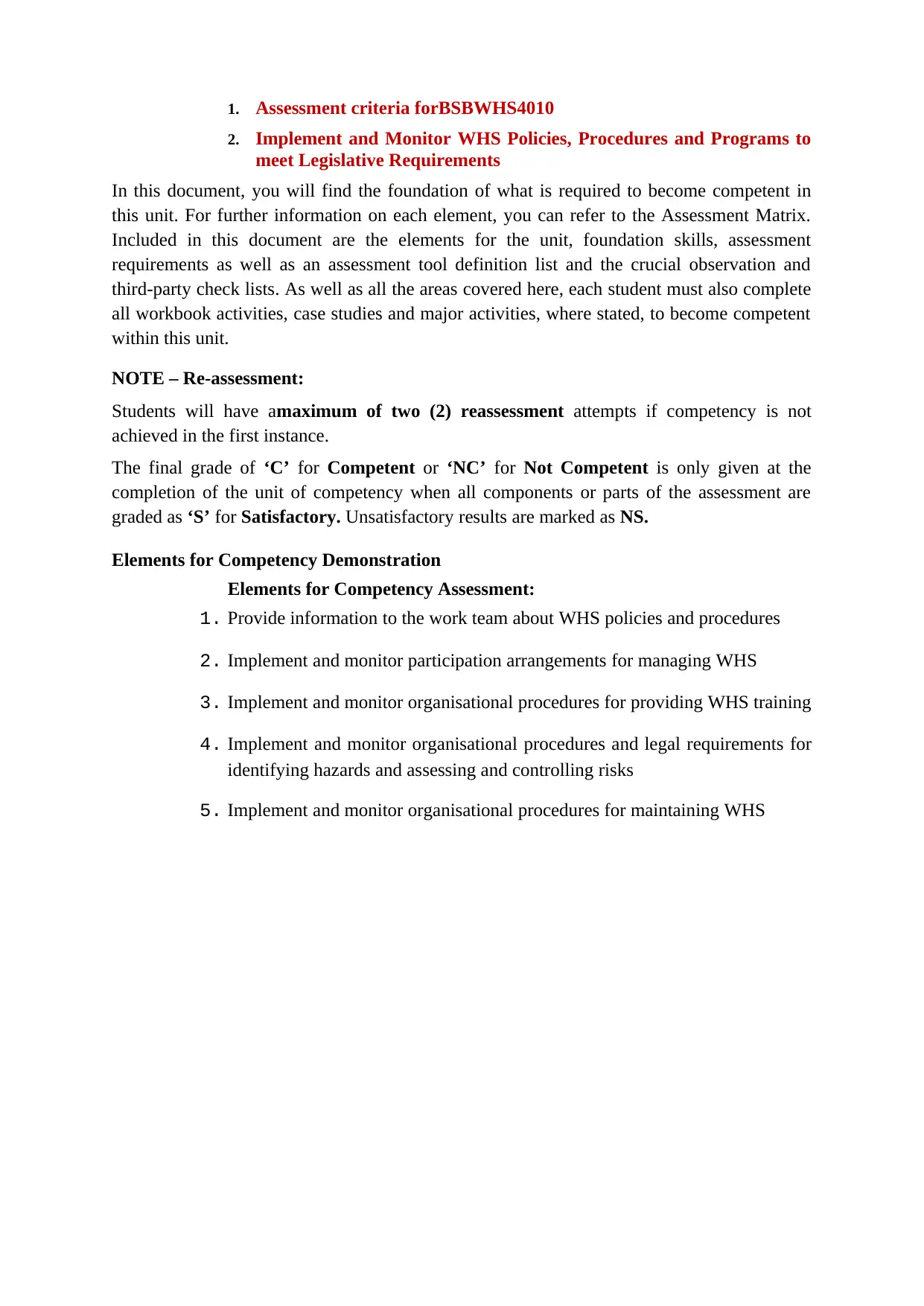
1. Assessment criteria forBSBWHS4010
2. Implement and Monitor WHS Policies, Procedures and Programs to
meet Legislative Requirements
In this document, you will find the foundation of what is required to become competent in
this unit. For further information on each element, you can refer to the Assessment Matrix.
Included in this document are the elements for the unit, foundation skills, assessment
requirements as well as an assessment tool definition list and the crucial observation and
third-party check lists. As well as all the areas covered here, each student must also complete
all workbook activities, case studies and major activities, where stated, to become competent
within this unit.
NOTE – Re-assessment:
Students will have amaximum of two (2) reassessment attempts if competency is not
achieved in the first instance.
The final grade of ‘C’ for Competent or ‘NC’ for Not Competent is only given at the
completion of the unit of competency when all components or parts of the assessment are
graded as ‘S’ for Satisfactory. Unsatisfactory results are marked as NS.
Elements for Competency Demonstration
Elements for Competency Assessment:
1. Provide information to the work team about WHS policies and procedures
2. Implement and monitor participation arrangements for managing WHS
3. Implement and monitor organisational procedures for providing WHS training
4. Implement and monitor organisational procedures and legal requirements for
identifying hazards and assessing and controlling risks
5. Implement and monitor organisational procedures for maintaining WHS
2. Implement and Monitor WHS Policies, Procedures and Programs to
meet Legislative Requirements
In this document, you will find the foundation of what is required to become competent in
this unit. For further information on each element, you can refer to the Assessment Matrix.
Included in this document are the elements for the unit, foundation skills, assessment
requirements as well as an assessment tool definition list and the crucial observation and
third-party check lists. As well as all the areas covered here, each student must also complete
all workbook activities, case studies and major activities, where stated, to become competent
within this unit.
NOTE – Re-assessment:
Students will have amaximum of two (2) reassessment attempts if competency is not
achieved in the first instance.
The final grade of ‘C’ for Competent or ‘NC’ for Not Competent is only given at the
completion of the unit of competency when all components or parts of the assessment are
graded as ‘S’ for Satisfactory. Unsatisfactory results are marked as NS.
Elements for Competency Demonstration
Elements for Competency Assessment:
1. Provide information to the work team about WHS policies and procedures
2. Implement and monitor participation arrangements for managing WHS
3. Implement and monitor organisational procedures for providing WHS training
4. Implement and monitor organisational procedures and legal requirements for
identifying hazards and assessing and controlling risks
5. Implement and monitor organisational procedures for maintaining WHS
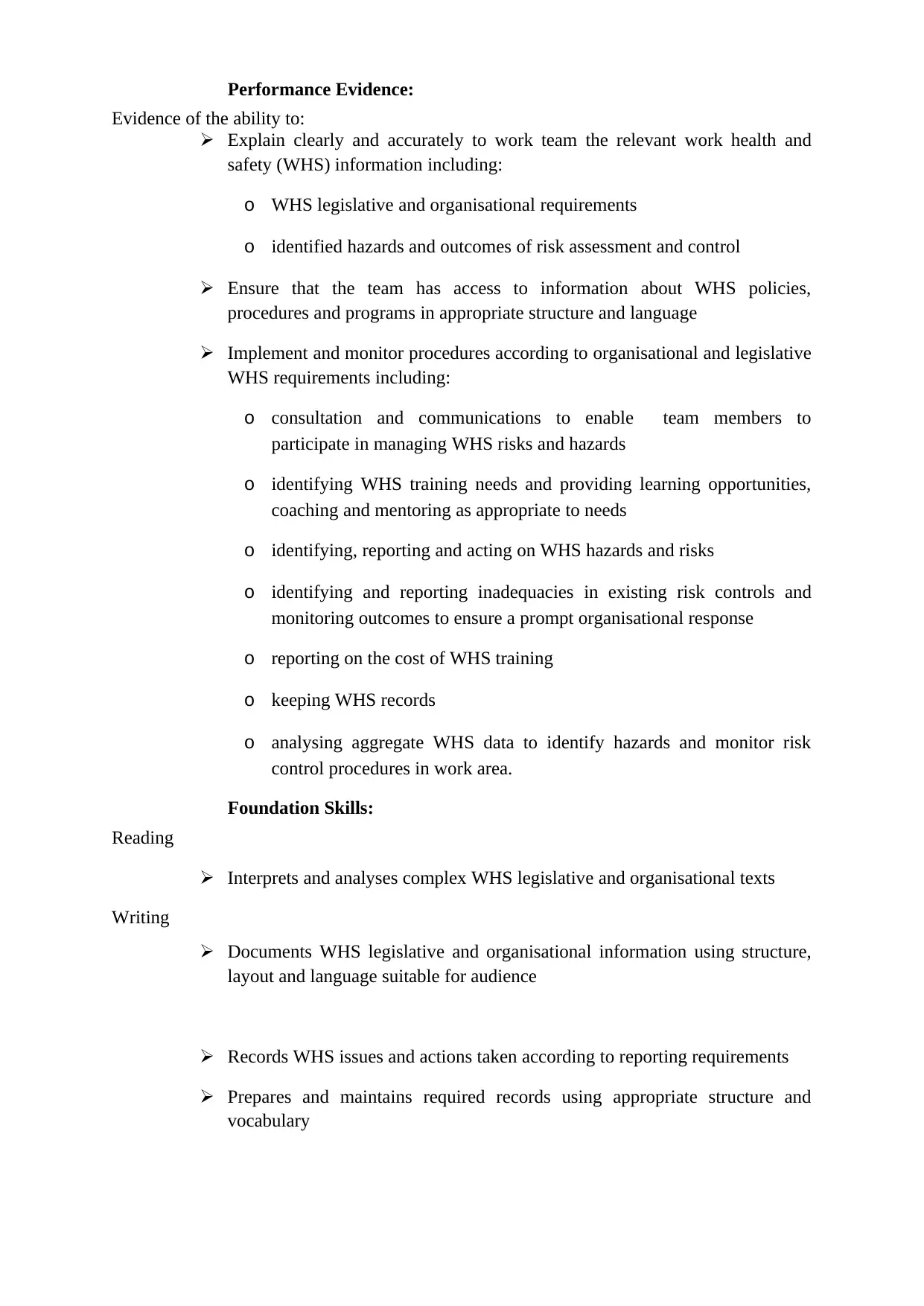
Performance Evidence:
Evidence of the ability to:
Explain clearly and accurately to work team the relevant work health and
safety (WHS) information including:
o WHS legislative and organisational requirements
o identified hazards and outcomes of risk assessment and control
Ensure that the team has access to information about WHS policies,
procedures and programs in appropriate structure and language
Implement and monitor procedures according to organisational and legislative
WHS requirements including:
o consultation and communications to enable team members to
participate in managing WHS risks and hazards
o identifying WHS training needs and providing learning opportunities,
coaching and mentoring as appropriate to needs
o identifying, reporting and acting on WHS hazards and risks
o identifying and reporting inadequacies in existing risk controls and
monitoring outcomes to ensure a prompt organisational response
o reporting on the cost of WHS training
o keeping WHS records
o analysing aggregate WHS data to identify hazards and monitor risk
control procedures in work area.
Foundation Skills:
Reading
Interprets and analyses complex WHS legislative and organisational texts
Writing
Documents WHS legislative and organisational information using structure,
layout and language suitable for audience
Records WHS issues and actions taken according to reporting requirements
Prepares and maintains required records using appropriate structure and
vocabulary
Evidence of the ability to:
Explain clearly and accurately to work team the relevant work health and
safety (WHS) information including:
o WHS legislative and organisational requirements
o identified hazards and outcomes of risk assessment and control
Ensure that the team has access to information about WHS policies,
procedures and programs in appropriate structure and language
Implement and monitor procedures according to organisational and legislative
WHS requirements including:
o consultation and communications to enable team members to
participate in managing WHS risks and hazards
o identifying WHS training needs and providing learning opportunities,
coaching and mentoring as appropriate to needs
o identifying, reporting and acting on WHS hazards and risks
o identifying and reporting inadequacies in existing risk controls and
monitoring outcomes to ensure a prompt organisational response
o reporting on the cost of WHS training
o keeping WHS records
o analysing aggregate WHS data to identify hazards and monitor risk
control procedures in work area.
Foundation Skills:
Reading
Interprets and analyses complex WHS legislative and organisational texts
Writing
Documents WHS legislative and organisational information using structure,
layout and language suitable for audience
Records WHS issues and actions taken according to reporting requirements
Prepares and maintains required records using appropriate structure and
vocabulary
⊘ This is a preview!⊘
Do you want full access?
Subscribe today to unlock all pages.

Trusted by 1+ million students worldwide
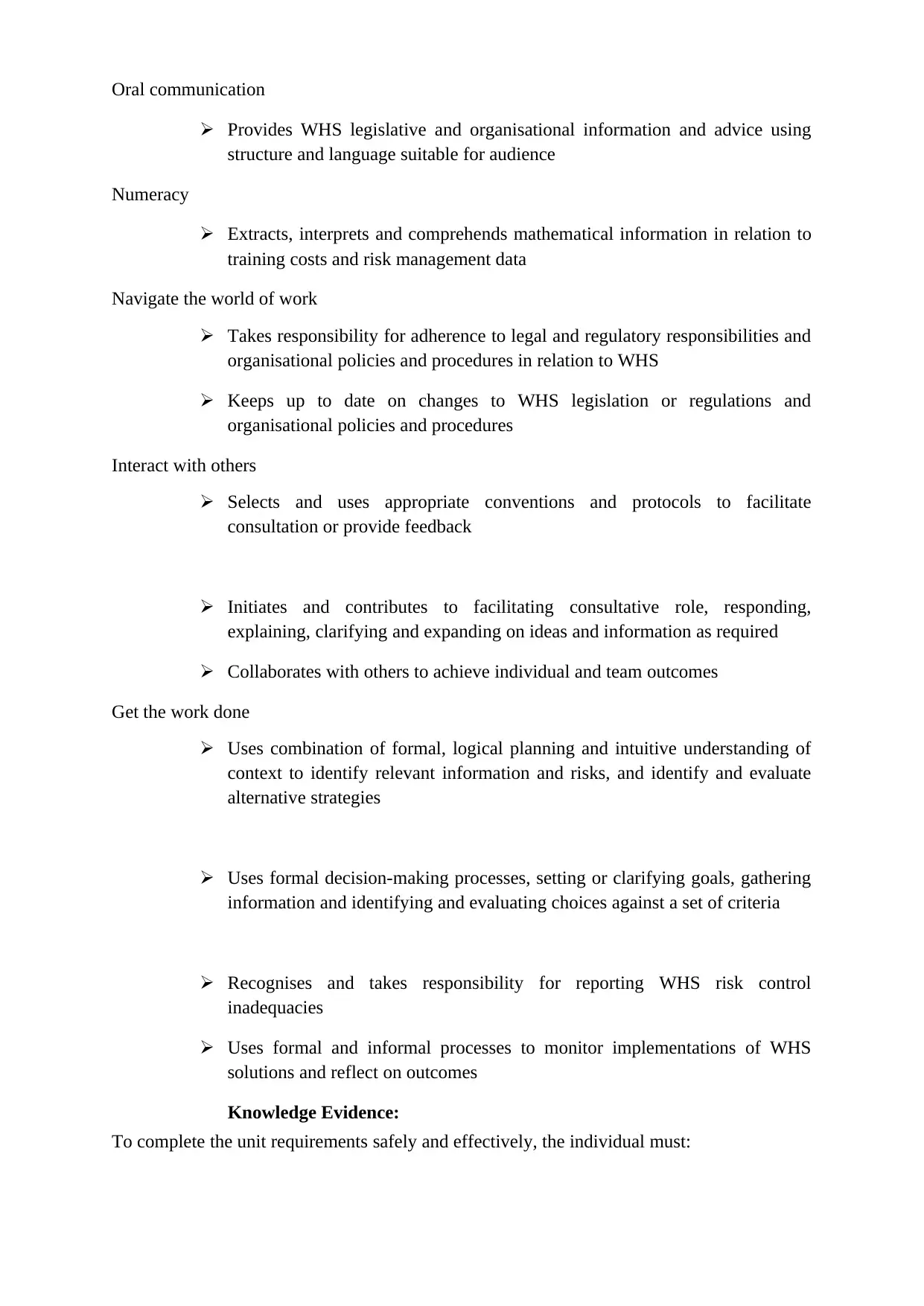
Oral communication
Provides WHS legislative and organisational information and advice using
structure and language suitable for audience
Numeracy
Extracts, interprets and comprehends mathematical information in relation to
training costs and risk management data
Navigate the world of work
Takes responsibility for adherence to legal and regulatory responsibilities and
organisational policies and procedures in relation to WHS
Keeps up to date on changes to WHS legislation or regulations and
organisational policies and procedures
Interact with others
Selects and uses appropriate conventions and protocols to facilitate
consultation or provide feedback
Initiates and contributes to facilitating consultative role, responding,
explaining, clarifying and expanding on ideas and information as required
Collaborates with others to achieve individual and team outcomes
Get the work done
Uses combination of formal, logical planning and intuitive understanding of
context to identify relevant information and risks, and identify and evaluate
alternative strategies
Uses formal decision-making processes, setting or clarifying goals, gathering
information and identifying and evaluating choices against a set of criteria
Recognises and takes responsibility for reporting WHS risk control
inadequacies
Uses formal and informal processes to monitor implementations of WHS
solutions and reflect on outcomes
Knowledge Evidence:
To complete the unit requirements safely and effectively, the individual must:
Provides WHS legislative and organisational information and advice using
structure and language suitable for audience
Numeracy
Extracts, interprets and comprehends mathematical information in relation to
training costs and risk management data
Navigate the world of work
Takes responsibility for adherence to legal and regulatory responsibilities and
organisational policies and procedures in relation to WHS
Keeps up to date on changes to WHS legislation or regulations and
organisational policies and procedures
Interact with others
Selects and uses appropriate conventions and protocols to facilitate
consultation or provide feedback
Initiates and contributes to facilitating consultative role, responding,
explaining, clarifying and expanding on ideas and information as required
Collaborates with others to achieve individual and team outcomes
Get the work done
Uses combination of formal, logical planning and intuitive understanding of
context to identify relevant information and risks, and identify and evaluate
alternative strategies
Uses formal decision-making processes, setting or clarifying goals, gathering
information and identifying and evaluating choices against a set of criteria
Recognises and takes responsibility for reporting WHS risk control
inadequacies
Uses formal and informal processes to monitor implementations of WHS
solutions and reflect on outcomes
Knowledge Evidence:
To complete the unit requirements safely and effectively, the individual must:
Paraphrase This Document
Need a fresh take? Get an instant paraphrase of this document with our AI Paraphraser

Outline the legal responsibilities and duties of managers, supervisors, persons
conducting businesses or undertakings (PCBUS) and workers in relation to
WHS risk management in the workplace
Identify key provisions of relevant WHS Acts, regulations and codes of
practice that apply to the business and outline how they apply in the work area
Explain organisational policies and procedures relating to hazard
identification, risk management, fire, emergency and evacuation, incident
investigation and reporting
Explain the importance of effective consultation mechanisms in managing
health and safety risks in the workplace
Explain how the hierarchy of control applies in the work area.
Assessment Conditions:
Assessment must be conducted in a safe environment where evidence gathered demonstrates
consistent performance of typical activities experienced by individuals carrying out work
health and safety duties in the workplace and include access to:
An actual workplace or simulated environment
Workplace equipment and resources
Examples of documents relating to workplace safety, hazard identification
and risk assessment
Interaction with others.
Assessors must satisfy NVR/AQTF assessor requirements.
Links:
Companion volumes available from the IBSA website:
http://www.ibsa.org.au/companion_volumes - http://www.ibsa.org.au/companion_volumes
Any observations and practical assessments must be recorded in the observation checklist.
All practical tasks should be demonstrated during the length of the course. As the instructor,
you must maintain a record demonstrating the date of the practical activities and any
comments relevant to the performance of each student. Where a student is not able to
demonstrate competence in a practical observation activity, further questioning should be put
in its place.
As the instructor, you could be assessing the student’s literacy, numeracy and language skills,
as well as the content and context of his/her answers.
conducting businesses or undertakings (PCBUS) and workers in relation to
WHS risk management in the workplace
Identify key provisions of relevant WHS Acts, regulations and codes of
practice that apply to the business and outline how they apply in the work area
Explain organisational policies and procedures relating to hazard
identification, risk management, fire, emergency and evacuation, incident
investigation and reporting
Explain the importance of effective consultation mechanisms in managing
health and safety risks in the workplace
Explain how the hierarchy of control applies in the work area.
Assessment Conditions:
Assessment must be conducted in a safe environment where evidence gathered demonstrates
consistent performance of typical activities experienced by individuals carrying out work
health and safety duties in the workplace and include access to:
An actual workplace or simulated environment
Workplace equipment and resources
Examples of documents relating to workplace safety, hazard identification
and risk assessment
Interaction with others.
Assessors must satisfy NVR/AQTF assessor requirements.
Links:
Companion volumes available from the IBSA website:
http://www.ibsa.org.au/companion_volumes - http://www.ibsa.org.au/companion_volumes
Any observations and practical assessments must be recorded in the observation checklist.
All practical tasks should be demonstrated during the length of the course. As the instructor,
you must maintain a record demonstrating the date of the practical activities and any
comments relevant to the performance of each student. Where a student is not able to
demonstrate competence in a practical observation activity, further questioning should be put
in its place.
As the instructor, you could be assessing the student’s literacy, numeracy and language skills,
as well as the content and context of his/her answers.
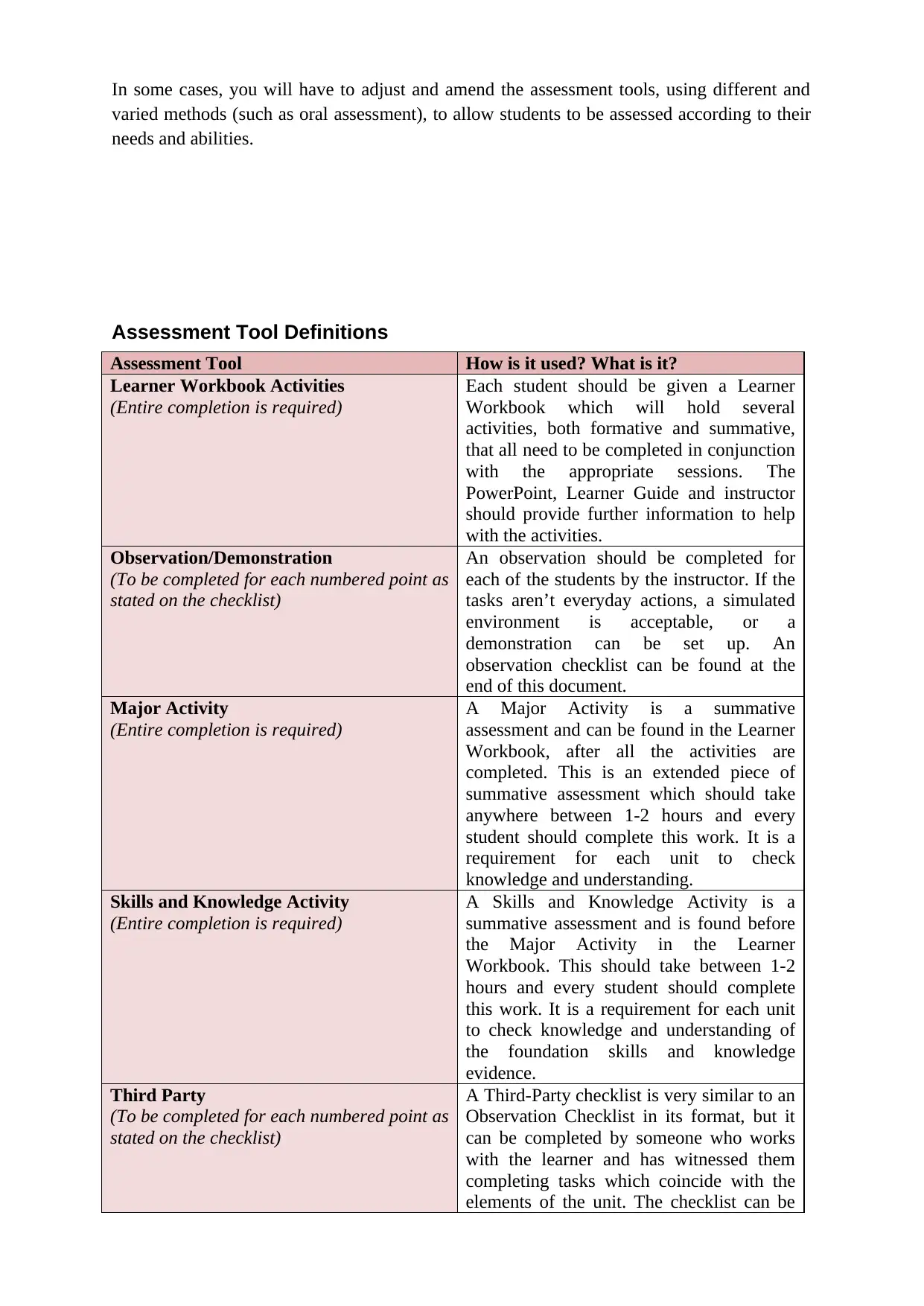
In some cases, you will have to adjust and amend the assessment tools, using different and
varied methods (such as oral assessment), to allow students to be assessed according to their
needs and abilities.
Assessment Tool Definitions
Assessment Tool How is it used? What is it?
Learner Workbook Activities
(Entire completion is required)
Each student should be given a Learner
Workbook which will hold several
activities, both formative and summative,
that all need to be completed in conjunction
with the appropriate sessions. The
PowerPoint, Learner Guide and instructor
should provide further information to help
with the activities.
Observation/Demonstration
(To be completed for each numbered point as
stated on the checklist)
An observation should be completed for
each of the students by the instructor. If the
tasks aren’t everyday actions, a simulated
environment is acceptable, or a
demonstration can be set up. An
observation checklist can be found at the
end of this document.
Major Activity
(Entire completion is required)
A Major Activity is a summative
assessment and can be found in the Learner
Workbook, after all the activities are
completed. This is an extended piece of
summative assessment which should take
anywhere between 1-2 hours and every
student should complete this work. It is a
requirement for each unit to check
knowledge and understanding.
Skills and Knowledge Activity
(Entire completion is required)
A Skills and Knowledge Activity is a
summative assessment and is found before
the Major Activity in the Learner
Workbook. This should take between 1-2
hours and every student should complete
this work. It is a requirement for each unit
to check knowledge and understanding of
the foundation skills and knowledge
evidence.
Third Party
(To be completed for each numbered point as
stated on the checklist)
A Third-Party checklist is very similar to an
Observation Checklist in its format, but it
can be completed by someone who works
with the learner and has witnessed them
completing tasks which coincide with the
elements of the unit. The checklist can be
varied methods (such as oral assessment), to allow students to be assessed according to their
needs and abilities.
Assessment Tool Definitions
Assessment Tool How is it used? What is it?
Learner Workbook Activities
(Entire completion is required)
Each student should be given a Learner
Workbook which will hold several
activities, both formative and summative,
that all need to be completed in conjunction
with the appropriate sessions. The
PowerPoint, Learner Guide and instructor
should provide further information to help
with the activities.
Observation/Demonstration
(To be completed for each numbered point as
stated on the checklist)
An observation should be completed for
each of the students by the instructor. If the
tasks aren’t everyday actions, a simulated
environment is acceptable, or a
demonstration can be set up. An
observation checklist can be found at the
end of this document.
Major Activity
(Entire completion is required)
A Major Activity is a summative
assessment and can be found in the Learner
Workbook, after all the activities are
completed. This is an extended piece of
summative assessment which should take
anywhere between 1-2 hours and every
student should complete this work. It is a
requirement for each unit to check
knowledge and understanding.
Skills and Knowledge Activity
(Entire completion is required)
A Skills and Knowledge Activity is a
summative assessment and is found before
the Major Activity in the Learner
Workbook. This should take between 1-2
hours and every student should complete
this work. It is a requirement for each unit
to check knowledge and understanding of
the foundation skills and knowledge
evidence.
Third Party
(To be completed for each numbered point as
stated on the checklist)
A Third-Party checklist is very similar to an
Observation Checklist in its format, but it
can be completed by someone who works
with the learner and has witnessed them
completing tasks which coincide with the
elements of the unit. The checklist can be
⊘ This is a preview!⊘
Do you want full access?
Subscribe today to unlock all pages.

Trusted by 1+ million students worldwide
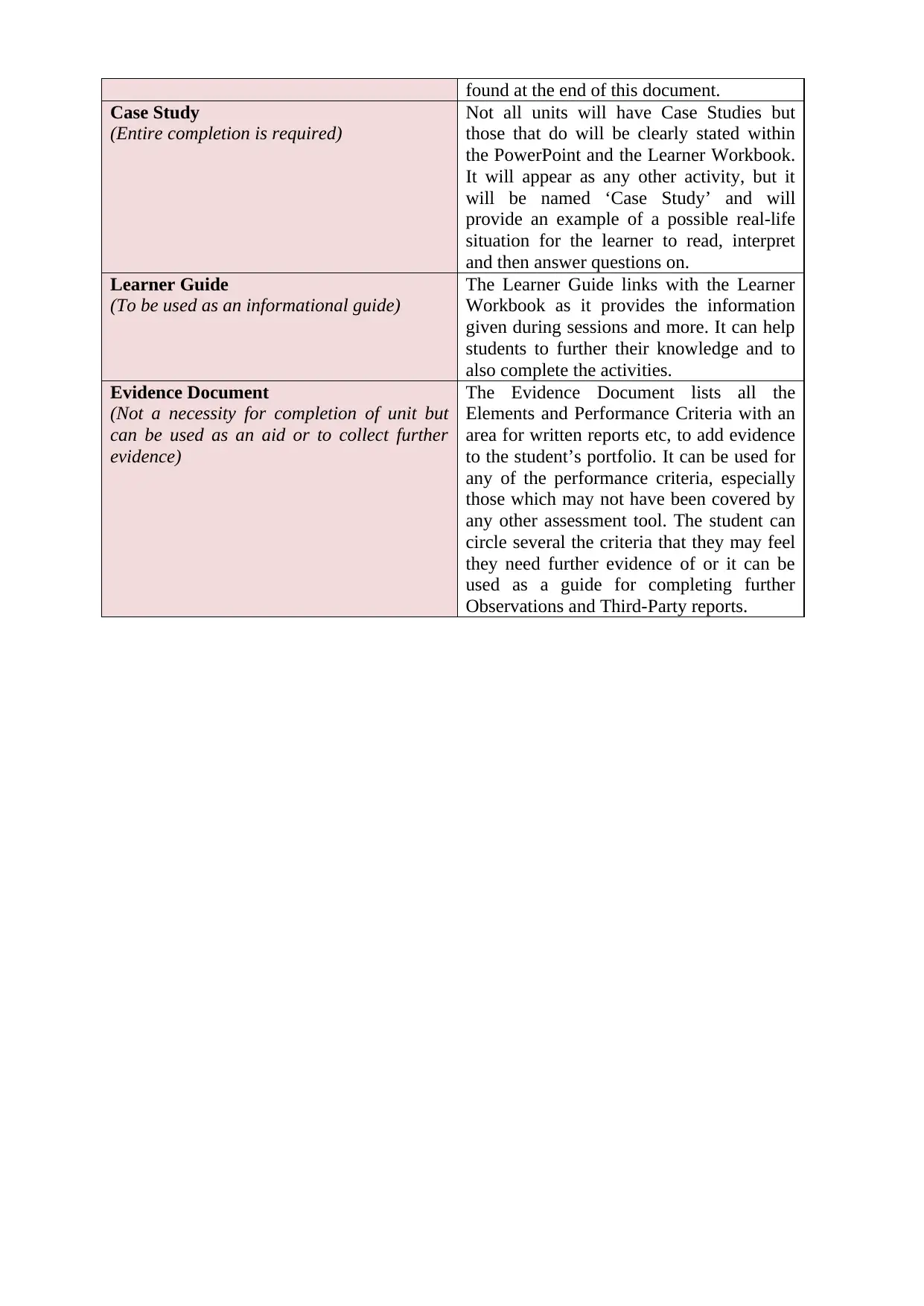
found at the end of this document.
Case Study
(Entire completion is required)
Not all units will have Case Studies but
those that do will be clearly stated within
the PowerPoint and the Learner Workbook.
It will appear as any other activity, but it
will be named ‘Case Study’ and will
provide an example of a possible real-life
situation for the learner to read, interpret
and then answer questions on.
Learner Guide
(To be used as an informational guide)
The Learner Guide links with the Learner
Workbook as it provides the information
given during sessions and more. It can help
students to further their knowledge and to
also complete the activities.
Evidence Document
(Not a necessity for completion of unit but
can be used as an aid or to collect further
evidence)
The Evidence Document lists all the
Elements and Performance Criteria with an
area for written reports etc, to add evidence
to the student’s portfolio. It can be used for
any of the performance criteria, especially
those which may not have been covered by
any other assessment tool. The student can
circle several the criteria that they may feel
they need further evidence of or it can be
used as a guide for completing further
Observations and Third-Party reports.
Case Study
(Entire completion is required)
Not all units will have Case Studies but
those that do will be clearly stated within
the PowerPoint and the Learner Workbook.
It will appear as any other activity, but it
will be named ‘Case Study’ and will
provide an example of a possible real-life
situation for the learner to read, interpret
and then answer questions on.
Learner Guide
(To be used as an informational guide)
The Learner Guide links with the Learner
Workbook as it provides the information
given during sessions and more. It can help
students to further their knowledge and to
also complete the activities.
Evidence Document
(Not a necessity for completion of unit but
can be used as an aid or to collect further
evidence)
The Evidence Document lists all the
Elements and Performance Criteria with an
area for written reports etc, to add evidence
to the student’s portfolio. It can be used for
any of the performance criteria, especially
those which may not have been covered by
any other assessment tool. The student can
circle several the criteria that they may feel
they need further evidence of or it can be
used as a guide for completing further
Observations and Third-Party reports.
Paraphrase This Document
Need a fresh take? Get an instant paraphrase of this document with our AI Paraphraser
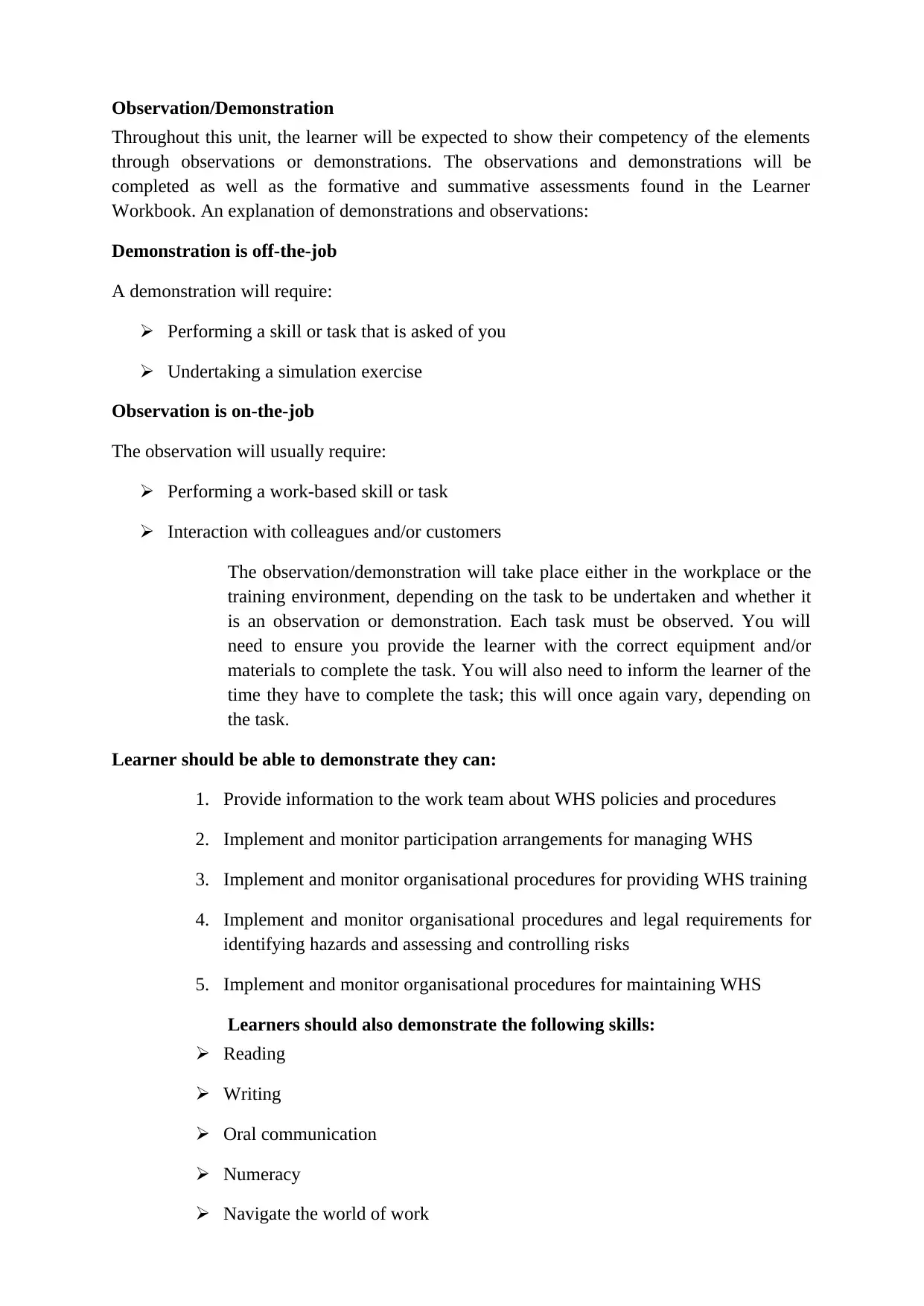
Observation/Demonstration
Throughout this unit, the learner will be expected to show their competency of the elements
through observations or demonstrations. The observations and demonstrations will be
completed as well as the formative and summative assessments found in the Learner
Workbook. An explanation of demonstrations and observations:
Demonstration is off-the-job
A demonstration will require:
Performing a skill or task that is asked of you
Undertaking a simulation exercise
Observation is on-the-job
The observation will usually require:
Performing a work-based skill or task
Interaction with colleagues and/or customers
The observation/demonstration will take place either in the workplace or the
training environment, depending on the task to be undertaken and whether it
is an observation or demonstration. Each task must be observed. You will
need to ensure you provide the learner with the correct equipment and/or
materials to complete the task. You will also need to inform the learner of the
time they have to complete the task; this will once again vary, depending on
the task.
Learner should be able to demonstrate they can:
1. Provide information to the work team about WHS policies and procedures
2. Implement and monitor participation arrangements for managing WHS
3. Implement and monitor organisational procedures for providing WHS training
4. Implement and monitor organisational procedures and legal requirements for
identifying hazards and assessing and controlling risks
5. Implement and monitor organisational procedures for maintaining WHS
Learners should also demonstrate the following skills:
Reading
Writing
Oral communication
Numeracy
Navigate the world of work
Throughout this unit, the learner will be expected to show their competency of the elements
through observations or demonstrations. The observations and demonstrations will be
completed as well as the formative and summative assessments found in the Learner
Workbook. An explanation of demonstrations and observations:
Demonstration is off-the-job
A demonstration will require:
Performing a skill or task that is asked of you
Undertaking a simulation exercise
Observation is on-the-job
The observation will usually require:
Performing a work-based skill or task
Interaction with colleagues and/or customers
The observation/demonstration will take place either in the workplace or the
training environment, depending on the task to be undertaken and whether it
is an observation or demonstration. Each task must be observed. You will
need to ensure you provide the learner with the correct equipment and/or
materials to complete the task. You will also need to inform the learner of the
time they have to complete the task; this will once again vary, depending on
the task.
Learner should be able to demonstrate they can:
1. Provide information to the work team about WHS policies and procedures
2. Implement and monitor participation arrangements for managing WHS
3. Implement and monitor organisational procedures for providing WHS training
4. Implement and monitor organisational procedures and legal requirements for
identifying hazards and assessing and controlling risks
5. Implement and monitor organisational procedures for maintaining WHS
Learners should also demonstrate the following skills:
Reading
Writing
Oral communication
Numeracy
Navigate the world of work

Interact with others
Get the work done
Get the work done
⊘ This is a preview!⊘
Do you want full access?
Subscribe today to unlock all pages.

Trusted by 1+ million students worldwide
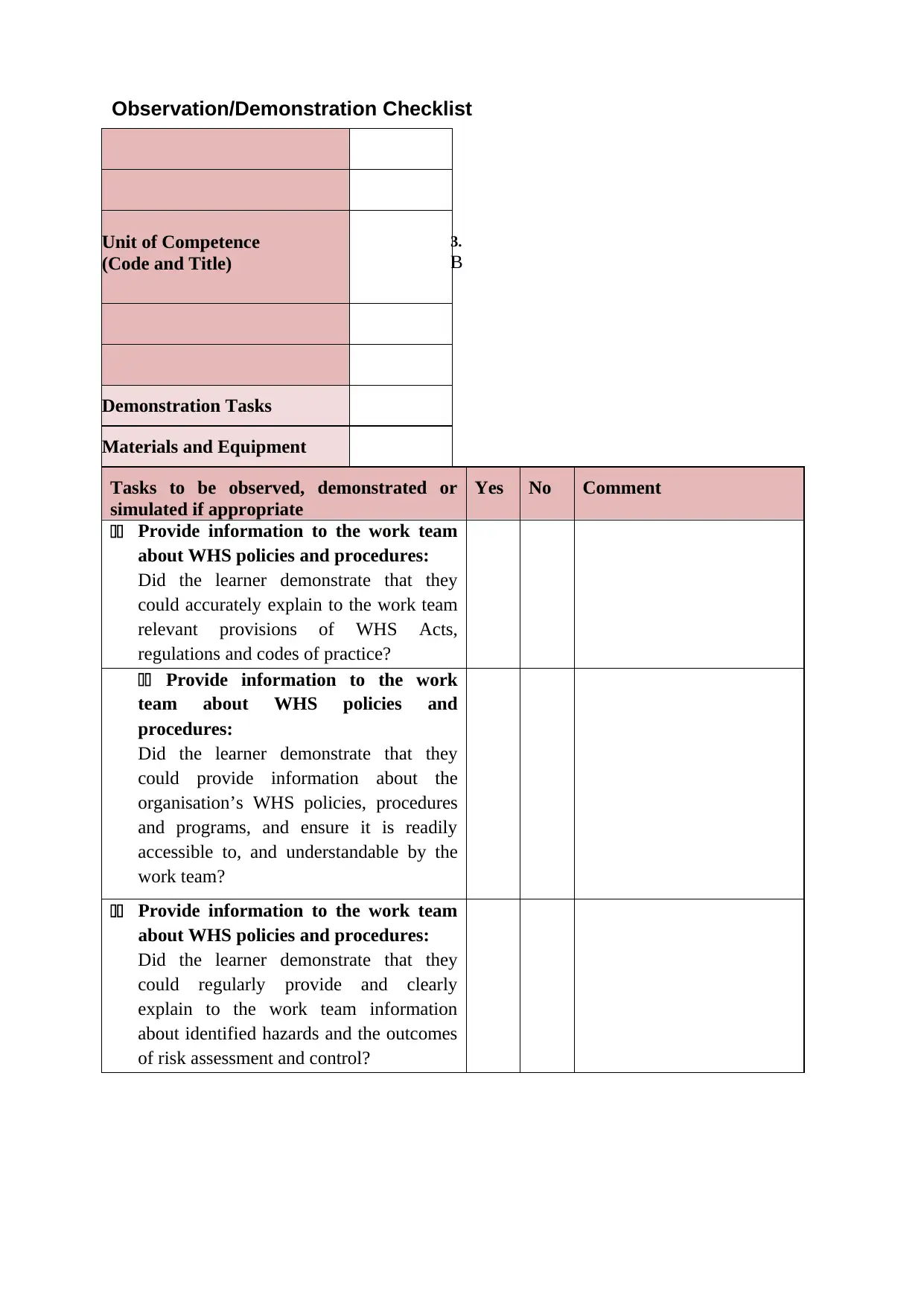
Observation/Demonstration Checklist
Unit of Competence
(Code and Title)
3.
B
Demonstration Tasks
Materials and Equipment
Tasks to be observed, demonstrated or
simulated if appropriate
Yes No Comment
11 Provide information to the work team
about WHS policies and procedures:
Did the learner demonstrate that they
could accurately explain to the work team
relevant provisions of WHS Acts,
regulations and codes of practice?
11 Provide information to the work
team about WHS policies and
procedures:
Did the learner demonstrate that they
could provide information about the
organisation’s WHS policies, procedures
and programs, and ensure it is readily
accessible to, and understandable by the
work team?
11 Provide information to the work team
about WHS policies and procedures:
Did the learner demonstrate that they
could regularly provide and clearly
explain to the work team information
about identified hazards and the outcomes
of risk assessment and control?
Unit of Competence
(Code and Title)
3.
B
Demonstration Tasks
Materials and Equipment
Tasks to be observed, demonstrated or
simulated if appropriate
Yes No Comment
11 Provide information to the work team
about WHS policies and procedures:
Did the learner demonstrate that they
could accurately explain to the work team
relevant provisions of WHS Acts,
regulations and codes of practice?
11 Provide information to the work
team about WHS policies and
procedures:
Did the learner demonstrate that they
could provide information about the
organisation’s WHS policies, procedures
and programs, and ensure it is readily
accessible to, and understandable by the
work team?
11 Provide information to the work team
about WHS policies and procedures:
Did the learner demonstrate that they
could regularly provide and clearly
explain to the work team information
about identified hazards and the outcomes
of risk assessment and control?
Paraphrase This Document
Need a fresh take? Get an instant paraphrase of this document with our AI Paraphraser
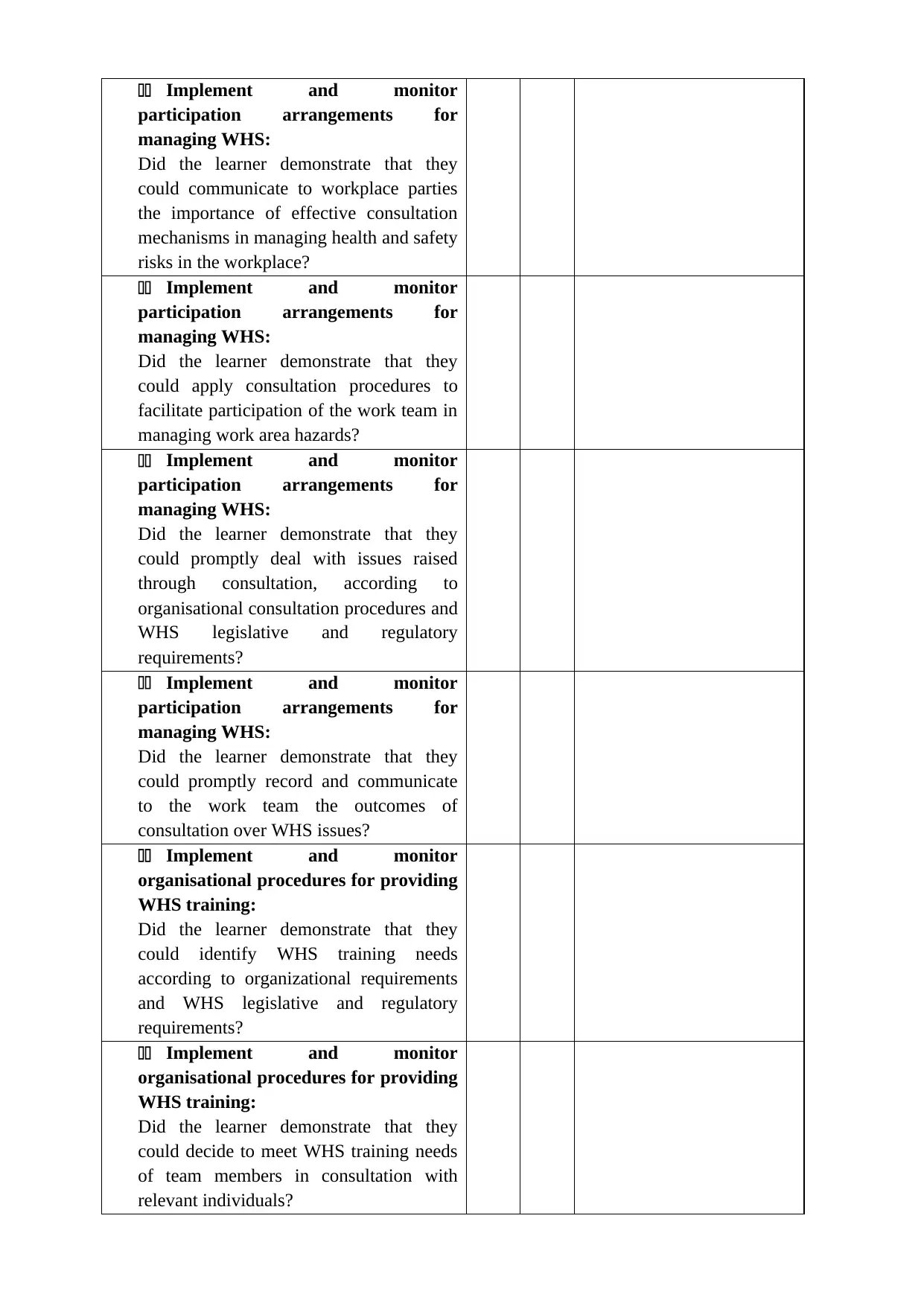
11 Implement and monitor
participation arrangements for
managing WHS:
Did the learner demonstrate that they
could communicate to workplace parties
the importance of effective consultation
mechanisms in managing health and safety
risks in the workplace?
11 Implement and monitor
participation arrangements for
managing WHS:
Did the learner demonstrate that they
could apply consultation procedures to
facilitate participation of the work team in
managing work area hazards?
11 Implement and monitor
participation arrangements for
managing WHS:
Did the learner demonstrate that they
could promptly deal with issues raised
through consultation, according to
organisational consultation procedures and
WHS legislative and regulatory
requirements?
11 Implement and monitor
participation arrangements for
managing WHS:
Did the learner demonstrate that they
could promptly record and communicate
to the work team the outcomes of
consultation over WHS issues?
11 Implement and monitor
organisational procedures for providing
WHS training:
Did the learner demonstrate that they
could identify WHS training needs
according to organizational requirements
and WHS legislative and regulatory
requirements?
11 Implement and monitor
organisational procedures for providing
WHS training:
Did the learner demonstrate that they
could decide to meet WHS training needs
of team members in consultation with
relevant individuals?
participation arrangements for
managing WHS:
Did the learner demonstrate that they
could communicate to workplace parties
the importance of effective consultation
mechanisms in managing health and safety
risks in the workplace?
11 Implement and monitor
participation arrangements for
managing WHS:
Did the learner demonstrate that they
could apply consultation procedures to
facilitate participation of the work team in
managing work area hazards?
11 Implement and monitor
participation arrangements for
managing WHS:
Did the learner demonstrate that they
could promptly deal with issues raised
through consultation, according to
organisational consultation procedures and
WHS legislative and regulatory
requirements?
11 Implement and monitor
participation arrangements for
managing WHS:
Did the learner demonstrate that they
could promptly record and communicate
to the work team the outcomes of
consultation over WHS issues?
11 Implement and monitor
organisational procedures for providing
WHS training:
Did the learner demonstrate that they
could identify WHS training needs
according to organizational requirements
and WHS legislative and regulatory
requirements?
11 Implement and monitor
organisational procedures for providing
WHS training:
Did the learner demonstrate that they
could decide to meet WHS training needs
of team members in consultation with
relevant individuals?
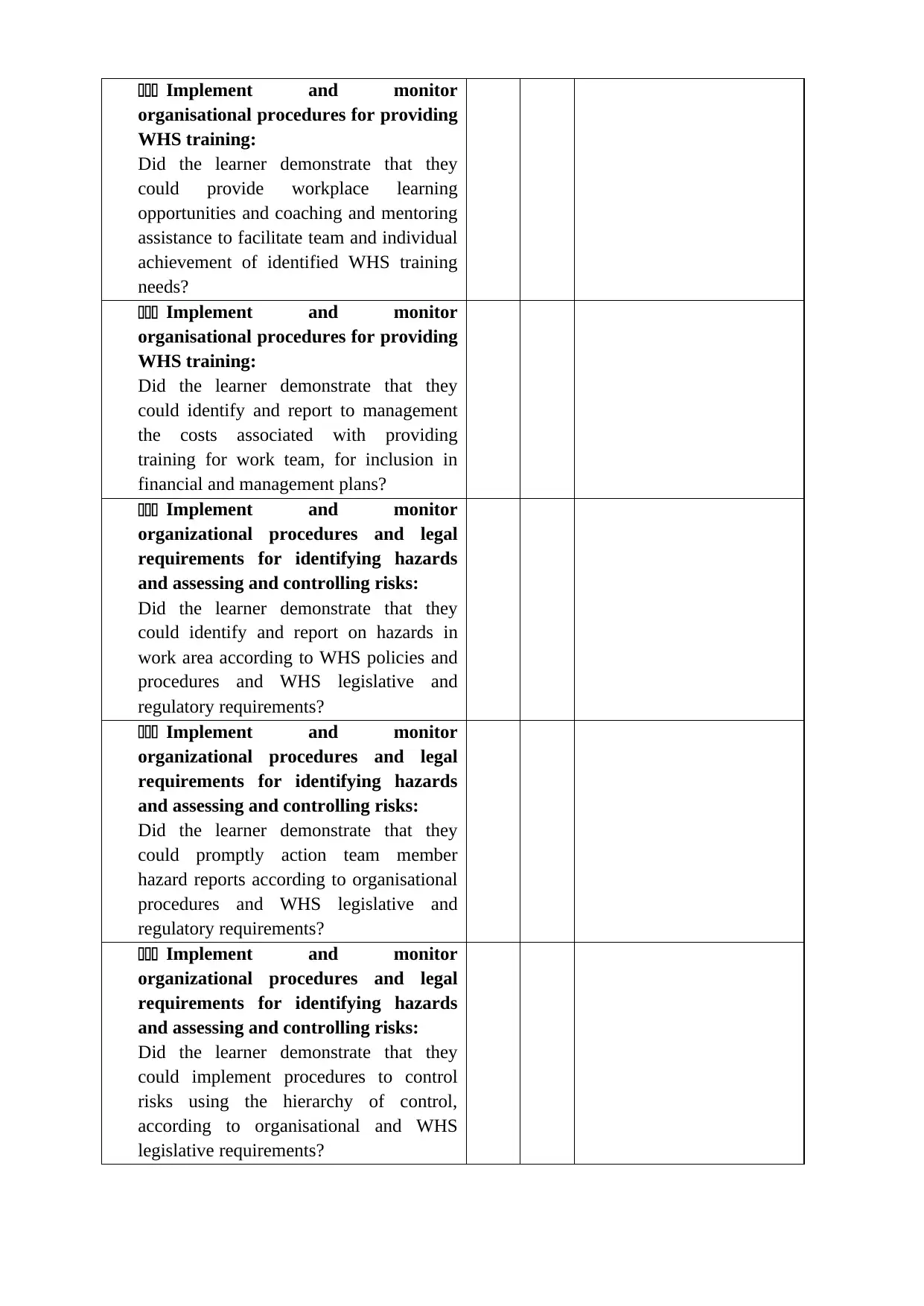
111 Implement and monitor
organisational procedures for providing
WHS training:
Did the learner demonstrate that they
could provide workplace learning
opportunities and coaching and mentoring
assistance to facilitate team and individual
achievement of identified WHS training
needs?
111 Implement and monitor
organisational procedures for providing
WHS training:
Did the learner demonstrate that they
could identify and report to management
the costs associated with providing
training for work team, for inclusion in
financial and management plans?
111 Implement and monitor
organizational procedures and legal
requirements for identifying hazards
and assessing and controlling risks:
Did the learner demonstrate that they
could identify and report on hazards in
work area according to WHS policies and
procedures and WHS legislative and
regulatory requirements?
111 Implement and monitor
organizational procedures and legal
requirements for identifying hazards
and assessing and controlling risks:
Did the learner demonstrate that they
could promptly action team member
hazard reports according to organisational
procedures and WHS legislative and
regulatory requirements?
111 Implement and monitor
organizational procedures and legal
requirements for identifying hazards
and assessing and controlling risks:
Did the learner demonstrate that they
could implement procedures to control
risks using the hierarchy of control,
according to organisational and WHS
legislative requirements?
organisational procedures for providing
WHS training:
Did the learner demonstrate that they
could provide workplace learning
opportunities and coaching and mentoring
assistance to facilitate team and individual
achievement of identified WHS training
needs?
111 Implement and monitor
organisational procedures for providing
WHS training:
Did the learner demonstrate that they
could identify and report to management
the costs associated with providing
training for work team, for inclusion in
financial and management plans?
111 Implement and monitor
organizational procedures and legal
requirements for identifying hazards
and assessing and controlling risks:
Did the learner demonstrate that they
could identify and report on hazards in
work area according to WHS policies and
procedures and WHS legislative and
regulatory requirements?
111 Implement and monitor
organizational procedures and legal
requirements for identifying hazards
and assessing and controlling risks:
Did the learner demonstrate that they
could promptly action team member
hazard reports according to organisational
procedures and WHS legislative and
regulatory requirements?
111 Implement and monitor
organizational procedures and legal
requirements for identifying hazards
and assessing and controlling risks:
Did the learner demonstrate that they
could implement procedures to control
risks using the hierarchy of control,
according to organisational and WHS
legislative requirements?
⊘ This is a preview!⊘
Do you want full access?
Subscribe today to unlock all pages.

Trusted by 1+ million students worldwide
1 out of 41
Related Documents
Your All-in-One AI-Powered Toolkit for Academic Success.
+13062052269
info@desklib.com
Available 24*7 on WhatsApp / Email
![[object Object]](/_next/static/media/star-bottom.7253800d.svg)
Unlock your academic potential
Copyright © 2020–2025 A2Z Services. All Rights Reserved. Developed and managed by ZUCOL.





